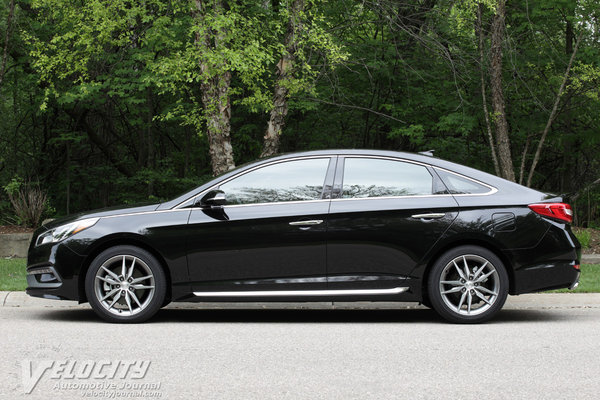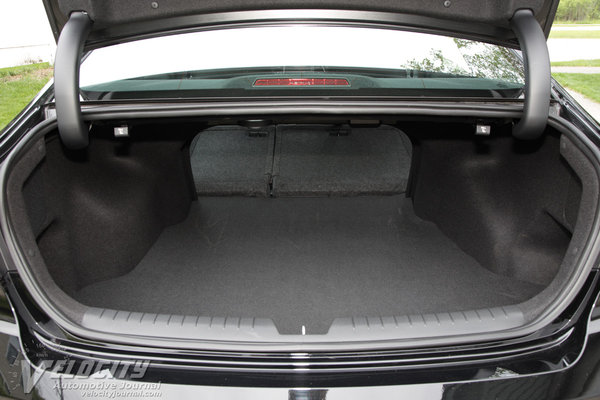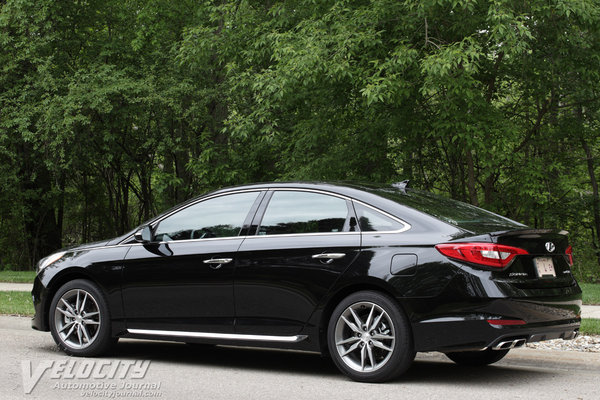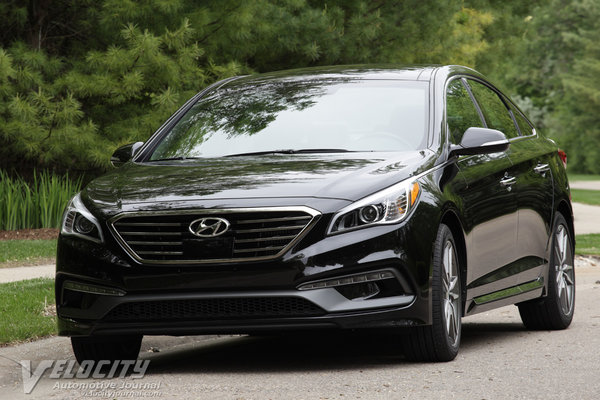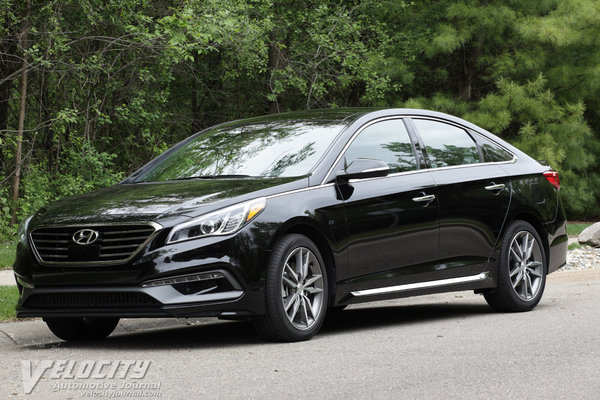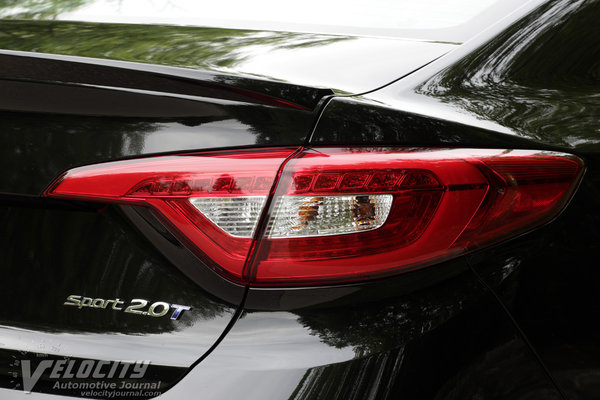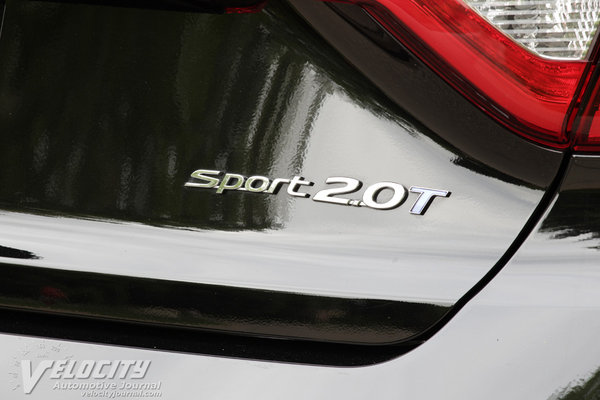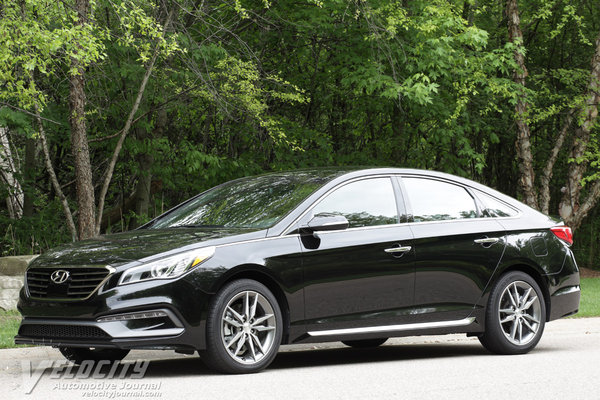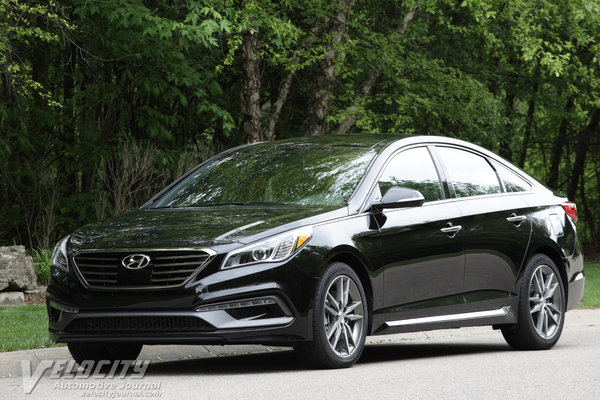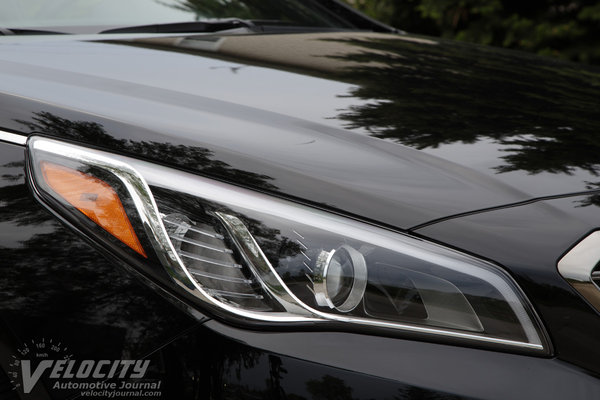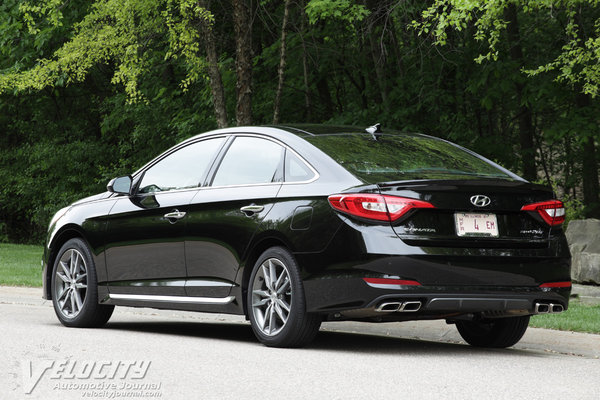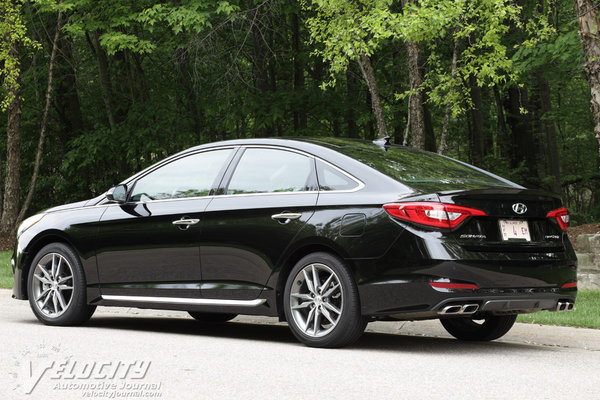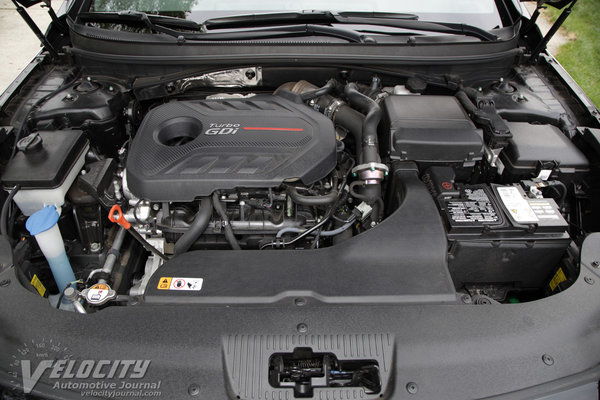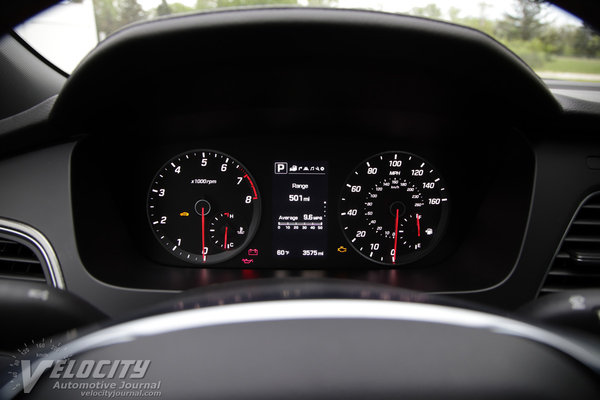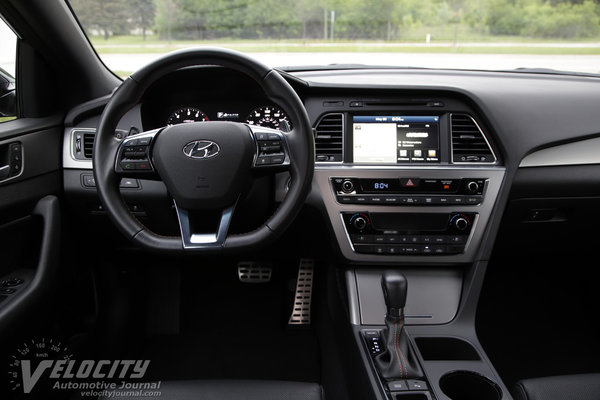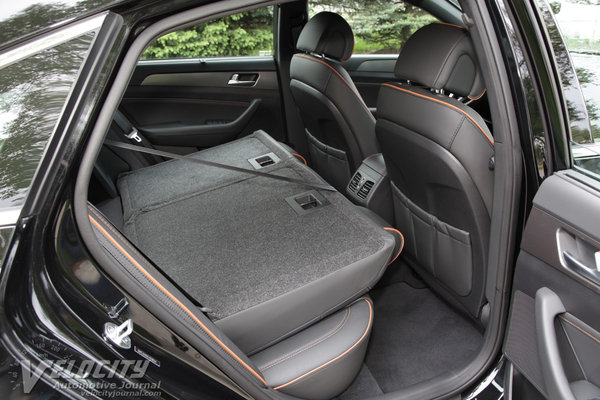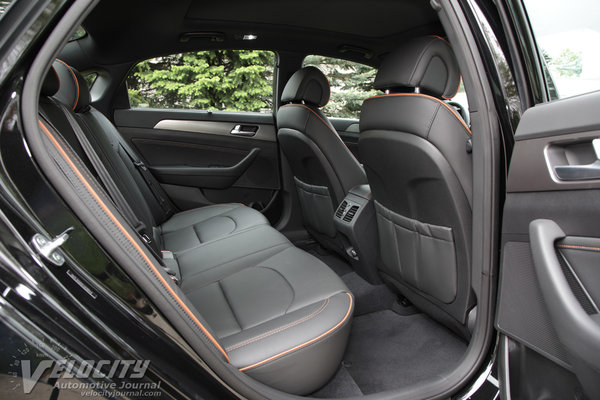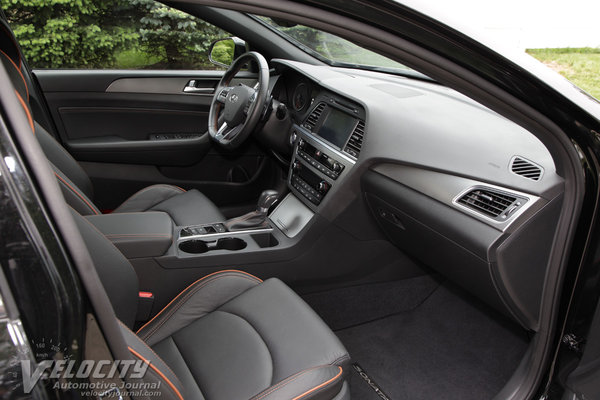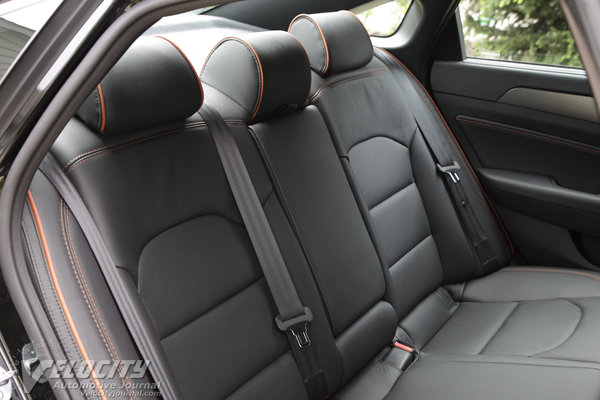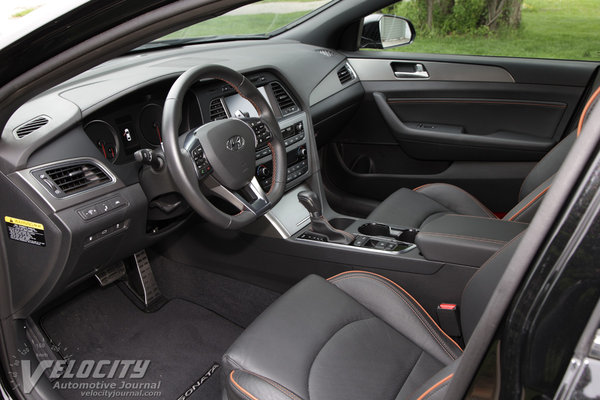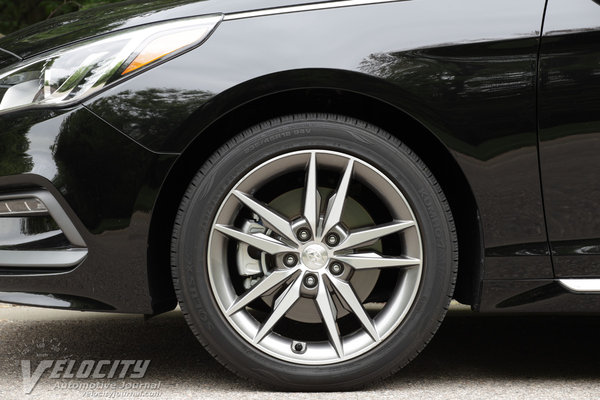2015 Hyundai Sonata 2.0T Sport
10/04/2015
Shahed Hussain
Hyundai introduced the 2015 Sonata just in time to take on updated midsize sedans from its Japanese and American rivals. Although sales are overshadowed by the Camry, Accord, Fusion, and Altima, Hyundai has nearly eliminated the perception that the Sonata is a second-tier alternative to the top-selling midsize sedans.
The 2015 Sonata lineup consists of three variants: SE, Sport, Limited and Eco. Pricing starts at $21,150 (SE) and ranges up to $33,525 (Limited 2.0T). Pricing for 2016 has predictably increased; the Sonata SE MSRP is $21,750 and tops out at $34,075 for the Limited 2.0T. Our test vehicle was a 2015 2.0T Sport ($28,575) equipped with the Ultimate Package ($4,950) and floor mats ($125) totaling up to $34,460 including the $810 freight and handling charge. Notable standard and optional equipment included a panoramic sunroof, 18-inch diameter alloy wheels, heated/ventilated front seats, heated rear seats, 9-speaker Infinity audio system, and navigation with 8-inch touch screen, smart cruise control, lane departure warning, forward collision warning, and leather seats.
Sonata powertrain choices consist of three inline-4 powerplants: 1.6L turbo, 2.4L and 2.0L turbo. The SE is powered by a 2.4L (185-bhp/178 lb.-ft.), while the Sport and Limited are available with both the 2.4L and a 2.0L turbo (245-bhp/260 lb.-ft.); both engines are coupled to a 6-speed automatic. The fuel economy-optimized Sonata Eco has a 1.6L turbo (178-bhp/195 lb.-ft.) combined with a 7-speed dual- clutch automatic. The Sport 2.0T we tested achieves an EPA 23/32 MPG (city/hwy.) rating. In our mixed urban and highway driving, fuel consumption was a reasonable, if unexceptional 27 MPG.
In an unusual decision, Hyundai reduced power output of both the normally-aspirated 2.4L and 2.0L turbo engines for the 2015 Sonata vs. the previous model. The 2.4L was rated at 192-bhp & 181 lb.-ft., while the 2.0L turbo cranked out 274-bhp/269 lb.-ft. According to Hyundai, maximum power output for both engines was reduced to enhance low and midrange torque as well throttle response for the turbo four.
A 2.0L turbo is becoming a common powerplant in midsize cars, and Hyundai follows the industry trend with its all-aluminum inline four. Like other engines in its class, the 2.0L is topped by dual overhead cams and continuously variable valve-timing. Peak power is 245-bhp @ 6,000 RPM and 260 lb.-ft. of torque is available from 1,350-4,000 RPM. A 6-speed automatic sends power to the front wheels via a 2.885:1 final drive ratio. Manual gearshifts are available via steering column paddles or the console shift lever.
The Sonata's chassis uses MacPherson struts and a stabilizer bar for the front suspension. At the back is a multi-link setup with coil springs, dampers and a stabilizer bar. Steering is via an electrically-assisted rack-and-pinion system with 2.78 turns lock-to-lock. Brakes consist of 12.6 in. diameter front discs complemented by 11.2 in. diameter rear discs. Kumho Solus XC P235/45R18 all-season tires are mounted on 18-inch diameter alloy wheels. ABS and electronic stability control are standard. Curb weight is 3,505 lbs.
Compared to the previous Sonata, Hyundai's most significant accomplishment is the much improved interior design and execution. Matte brushed aluminum trim on the console, dash and door panels looks appropriately expensive. The leather-wrapped steering wheel is contoured for grip and comfort. Audio, phone, and cruise control buttons are integrated on steering wheel spokes. The center console includes dual cupholders and a small storage bin, plus another compartment below the climate controls with USB ports for portable electronics.
The 8-way adjustable driver's seat provides excellent lateral support. Orange stitching on the shift knob and steering wheel matches with the piping on the perforated leather seats. The front passenger benefits from 6-way adjustments. Both front seats are heated and ventilated, so winter and summer comfort is a pushbutton away. Rear passengers are rewarded with ample legroom and supportive seats, although the center occupant position is only acceptable for short trips. The folding armrest has cupholders for rear passengers. A 12V outlet behind the center console is convenient to charge portable electronics.
Hyundai was serious about making the Sonata Sport live up to its name. Sharp steering response combined with firm damping gave us confidence to push the Hyundai's handling limits. Hyundai tuned the suspension to deliver consistently mild understeer and minimal body roll in typical street driving. At highway speeds, the Sonata's steering power assist seems excessive, so the minor road imperfections cause the chassis to deviate from a straight line. On the pitted and lumpy roads near Detroit, the rigid tire sidewalls transmitted most bumps into the passenger cabin and steering wheel. Wind and tire noise are subdued on the highway. We noticed slight torque steer during full throttle acceleration as the turbo spins up, but only minor steering corrections were required. The Sonata's disc brakes shed speed rapidly, but pedal travel is relatively short.
Active safety technologies are becoming common in midsize sedans as more manufacturers offer them as options. Hyundai's collision alert and blind spot warning sensors beep whenever the electronic sentries determine that the Sonata is approaching another vehicle too fast or if another car is in its blind spot. The blind spot warning was useful, but the collision alert warning is aimed at inattentive or inexperienced drivers.
The 2.0L turbo does an admirable job of delivering ample torque at low and midrange RPM, although there is a momentary delay before the turbo spins up. Maximum torque output is comparable to a 3.5L V-6, but the turbo four cannot match the immediate throttle response of a normally-aspirated six. The 6-speed automatic changes gears seamlessly, and will downshift quickly on demand. The steering wheel-mounted paddles are convenient, but we rarely needed to shift manually in normal urban driving.
Hyundai clearly devoted significant design and engineering resources to ensure that the Sonata remains competitive in the overcrowded midsize sedan segment. Instead of just aspiring to be the best value in its class, the Sonata now aims to be considered in the same league as the best American and Japanese family sedans. In its Sport 2.0T variant, the Sonata becomes one of the sharpest handling sedan in its class. However, the Japanese V-6 competition outguns the Hyundai with higher horsepower at a similar price point. We think that the Sonata Sport with the 2.4L inline-4 is the best value, combining fuel efficiency and affordable pricing, along with all the standard features we would expect.

